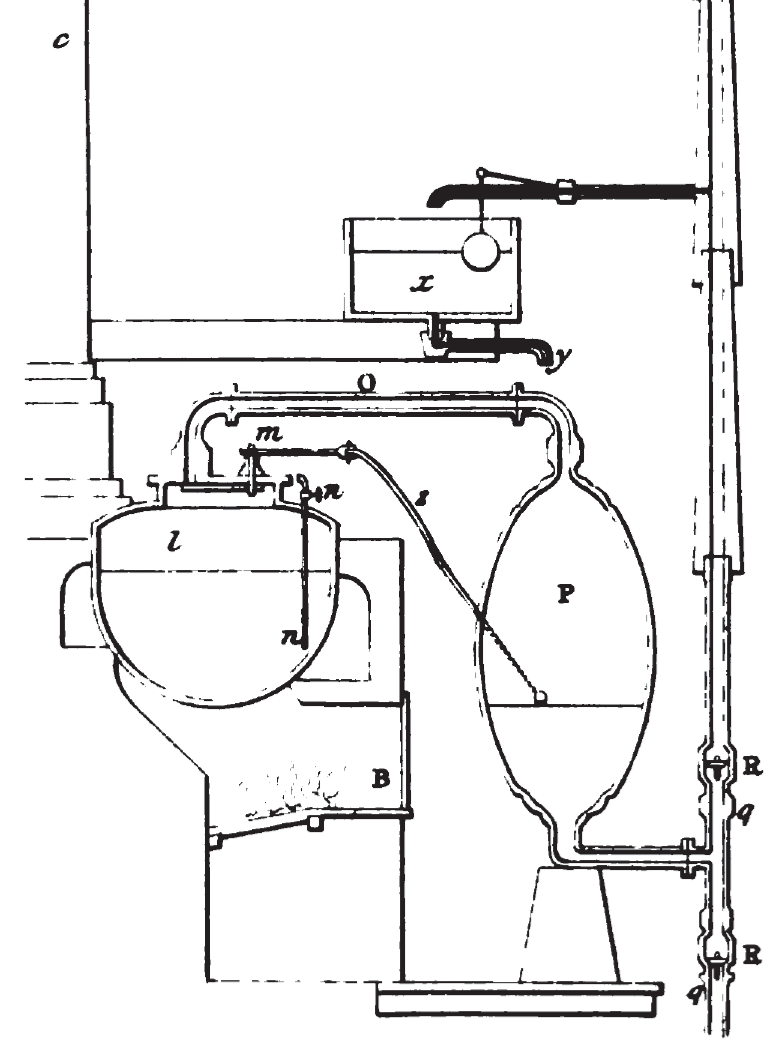Bunch-Hellemans, Recognizing the power of steam
That steam can exert power was known by the ancient Greeks. But as was the case with many of their discoveries, they applied this knowledge only to toys. Heron of Alexandria built such a toy, the aelopile. It consisted of a spherical vessel fitted with two jets pointing in opposite directions; when steam was admitted to the sphere, it escaped through the two jets, causing the sphere to rotate.
During the Renaissance there was renewed interest in the power of steam. Although it is not true that James Watt saw the lid rising on a pan of boiling water and got the idea for the steam engine, someone surely did. Noticing that steam in an enclosed place has the power to lift objects is the first step toward building a steam engine. Alternately, lifting with steam and letting the steam cool back into water is the simplest form of a steam engine. The natural philosopher Giambattista della Porta recognized the two advantageous aspects of steam: By creating pressure, steam could, for example, force water out of a vessel, or by condensing, it could create a vacuum. He demonstrated the latter property by filling a flask with steam and plunging it underwater. As the steam cooled and condensed, a vacuum formed in the flask, drawing in water.
It was Denis Papin, who had studied medicine and physics, who first thought of using steam to move a piston in a cylinder to deliver work. He started working for the French Academy of Science and became the assistant of Christiaan Huygens, the Dutch astronomer who was one of the founding members of the academy.
Huygens was then experimenting with air pumps and with a gunpowder engine. One of Huygens’s aims was to create a vacuum by exploding gunpowder in a cylinder with a piston. The piston would shoot to the top of the cylinder and thus create a vacuum.
Papin, who also experimented with such devices, found that steam was not only a much better agent to create a vacuum, but could be used to deliver work. His simple steam engine of 1690, also called Papin’s cylinder, consisted of a cylinder closed at the bottom, containing water, and sealed off by a movable piston. When the water boiled, the piston rose, and when the steam condensed, creating a vacuum, it descended. Papin, being primarily a scientist –– he even taught mathematics at a German university –– never did build a practical engine that could deliver mechanical work. People less removed from industry, such as the British engineer Thomas Savery and later Thomas Newcomen, devised the first machines that put steam to work.
The steam engines of the 1700s, when practical engines were first built, were all improvements on the idea behind Papin’s simple engine. The cylinder and piston later became the essential components of steam engines, but the first device that used steam for delivering work did not have a piston. It was invented by the British engineer Thomas Savery and was patented in 1698. His design, a water pump used for pumping water out of mines, and therefore called the Miner’s Friend, made use of both the ability of steam to exert pressure and to create a vacuum. First steam from a boiler was admitted to a vessel; after the steam supply valve was closed, it was condensed by a spray of water.
The created vacuum in the vessel raised water through a one-way valve; when the vessel was filled, steam was admitted into it again, forcing the water upward through a second one-way valve. Savery produced a working model of his steam pump, but there are no records of such engines being used in mines. It is known that one engine worked at the York Buildings in London, pumping water from the Thames. Its use was abandoned because of a number of technical difficulties –– the main one being that the precision workmanship and strength of materials at the time were insufficient for this type of machine.
